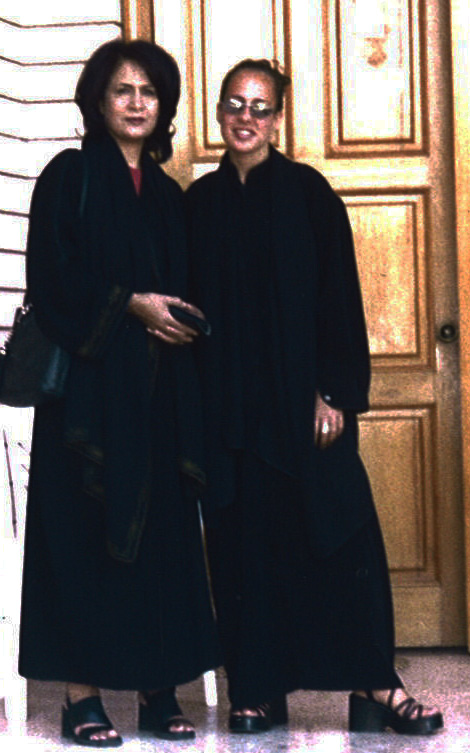Rawan Jabaji

Jabaji and her mother in abayas, in Saudi Arabia. |
The clothing police are cracking down on streaks of vibrant color, bands of glittering crystal and sexy leopard skin prints popping up on the runway—or rather, in this case, in Saudi Arabia’s marketplaces.
Women in Saudi Arabia are required to wear abayas, or shapeless robes, in public places at all times. The mutawa’a, or religious police, require that black abayas be worn loosely to the ground with a head covering. But now, women in Saudi Arabia are taking their black abayas to an entirely new level. Stores all over the kingdom have begun stocking their shops with new abayas embellished with splashes of beads, hints of color, and new fitted cuts.
As an Arab-American, the culture, customs and language of Saudi Arabia are by no means foreign to me. Having spent my early childhood years in Riyadh, I was accustomed to seeing my mother wrap herself in the abaya and venture to the market. But that was before the Gulf War—before the religious police tightened the grips on the kingdom. When I returned to Riyadh in the late 90s (due to my father’s work) I too sported one of these formless tent-like overcoats whenever I traveled in public. My mandatory black abaya was made of a bland chiffon material and conveniently zipped up in the front like a house robe. The scorching heat made my clothing choice under the abaya very simple: pool shorts and a tank top. I rarely ever did my hair or put any thought into my clothes, as I often do at home in New York, because I was restricted to dress within the rigid clothing code that left me feeling nameless. At that time, designer abayas were just starting to pop up. I’d see women wearing fitted abayas made with material from international fashion houses such as Fendi and Versace. But only a few women were togged up in these high-fashion abayas, the rest of us just wore abayas that looked like Hefty bags. I recall being reprimanded in a shopping mall by the religious police because my hairstyle—a simple bun—could be deciphered from under my veil. Another time I was stopped in the marketplace for having red pedicured toes.
But now the plain, shapeless abaya is something of the past. Feeling pressured to meet their clientele’s demands, shopkeepers and designers are putting their livelihoods at risk, facing fines or imprisonment for selling the stylized abayas. In the past, the religious police in Saudi Arabia have raided stores throughout Saudi Arabia, confiscating what they deem to be illicit abayas not in line with the kingdom’s rigid interpretation of Islamic teachings. As recently as last month, shopkeepers in Riyadh were ordered to stop selling adorned abayas.
In Saudi Arabia, home to the holiest site in Islam, these new stylized abayas aren’t solely a shift in style and taste, but rather an outright sign of relaxing social norms in the conservative kingdom.
The salesmen and designers in Saudi Arabia say that women are snapping up the new abayas. “We in Jiddah are fashion conscious,” said abaya designer Ghada al-Sairafi. “I try to come up with a new model every week because of the demand.”
Hanan al-Madani, another Jiddah designer, said abayas are “no longer just abayas.”
“Today, they reflect a woman’s taste and personality,” said al-Madani, whose custom-made abayas sell between $402 and $2,145.
Samar Falan, a Saudi Arabian women’s rights activist, is concerned that the crackdown on the trendy abayas will mark another setback for women in the kingdom.
“They [the mutawa’a] want women to be faceless, nameless and shrouded in blackness,’’ said Falan. “We kept quiet when we should have confronted the radicals. I believe Muslim women should dress modestly and cover their hair, but they do not have to look gruesome.”
In Turkey’s Tigers, WIDE ANGLE closely followed Mustafa Karaduman, the CEO of a Turkey’s largest Islamic-style clothing chain, Tekbir. Karaduman’s goal behind his multimillion dollar clothing empire is to encourage women to dress in Islamic style, adding splashes of style and flair to create more appeal. But this is in Turkey, a secular democracy with a predominantly Muslim population now negotiating membership in the European Union.
